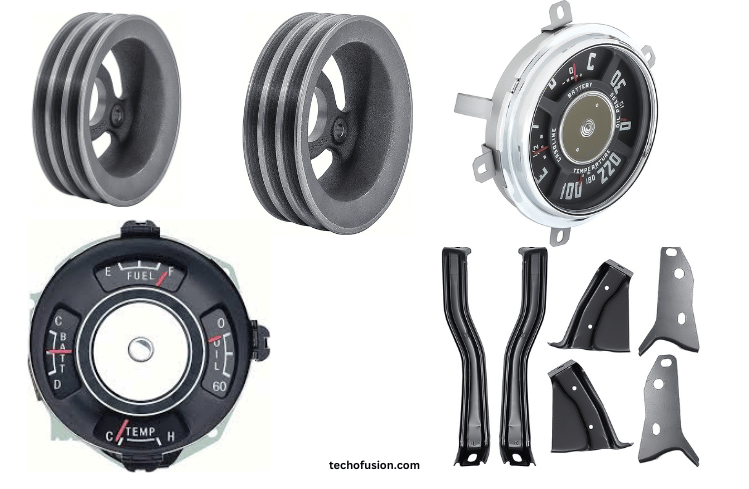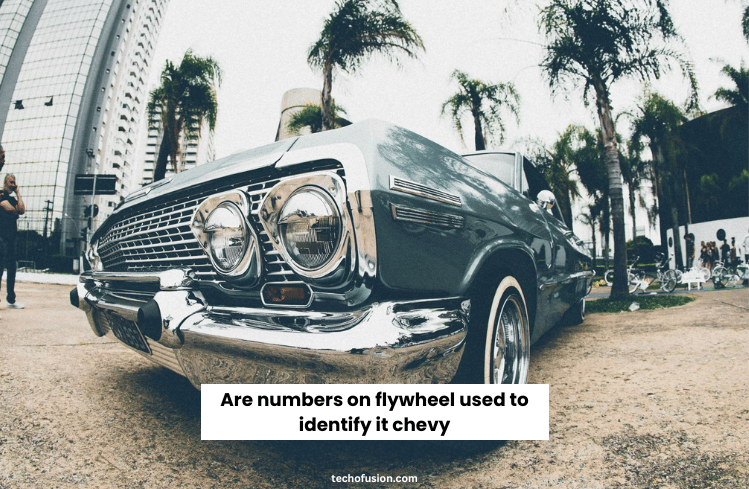The flywheel is a vital issue in Chevy engines, and for the ones running on older Chevy fashions much like the Chevy 350 or the 66 Chevelle 396, figuring out the right flywheel is crucial. But can the numbers stamped on a flywheel help you become aware of which engine it belongs to? In this text, we’ll discover are numbers on flywheel used to identify it Chevy? We’ll additionally speak small block Chevy flywheels, and Chevy block casting numbers and provide hints for matching flywheels with the ideal starter, seize, and engine components.
What Are Flywheel Numbers and Why Are They Important?
Flywheel numbers aren’t just random markings; they create treasured statistics that help mechanics and automobile lovers become aware of the proper flywheel for his or her Chevy engines. Whether you are running on a conventional 79 Nova or upgrading the overall performance of your Chevy 350, these numbers permit you to recognize specifications that include engine displacement, teeth rely, and engine stability.
Key Information in Chevy 350 Flywheel Numbers
The Chevy 350 flywheel is one of the most generally used additives in small-block Chevy engines, and the numbers stamped on it permit you to determine its key specifications:
- Engine Balance: Flywheels are both internally or externally balanced, and these statistics can be located inside the numbers on the flywheel. Using the wrong stability type can damage the engine through the years.
- Tooth Count: The Chevy 350 flywheel typically comes with either 153 or 168 teeth. It’s critical to realize this variety to fit the flywheel with the best starter motor and transmission gadget.
Small Block Chevy Flywheel Identification
The small block Chevy flywheel is a flexible factor, used in lots of Chevy engine configurations. The numbers on a small block Chevy flywheel let you know important info, including the crankshaft flange pattern and whether or not the flywheel is for a guide or automated transmission.
Here’s how these numbers let you:
- Tooth Count: Most small block Chevy flywheels could have both a 153-teeth or 168-tooth rely on. The tooth has to fit your starter to ensure smooth operation.
- Manual or Automatic: Flywheels for guide transmissions are normally known as “flywheels,” even as those for automatic transmissions are known as “flexplates.” The numbers will often imply which kind you’re dealing with.
Small Block Chevy Block Casting Numbers and Their Importance
Small block Chevy block casting numbers are another vital identifier whilst coping with Chevy engines. These numbers, usually located on the engine block, can tell you the engine’s displacement, year of manufacture, and the plant in which it was produced.
Understanding your block casting numbers is essential for matching parts like the flywheel. If your flywheel and engine block casting numbers don’t match up, you could end up with a misaligned starter or other operational issues.
Matching Casting Numbers to the Flywheel
When operating on small-block Chevy engines, the casting numbers may be used to make sure you’re putting in the proper flywheel. These numbers will permit you to recognize if the engine is from a car, truck, or marine software, all of which use barely extraordinary flywheel configurations.
66 Chevelle 396 Spark Plug Compatibility
If you are operating on a 66 Chevelle 396 spark, you’re likely trying to make sure that all the engine components work together flawlessly. The flywheel numbers on a 396 can help you verify compatibility together with your snatch and starter, however, they won’t offer information about other engine additives like 66 Chevelle 396 spark plugs.
For this engine, you may want to use ACDelco forty-one-993 Spark Plugs for the most excellent performance. These are regarded for their durability and are top-notch in shape for the massive block 396 engine. Always ensure that the flywheel you’re using matches the balance and tooth count needed for your particular transmission system.
How Flywheel Numbers Help with Identifying a 79 Nova Flywheel
The 79 Nova is another classic Chevy model where flywheel numbers can be essential. Whether you’re restoring a Nova or upgrading parts, knowing how to interpret the flywheel numbers will help ensure that you have the right match for your engine and transmission.
- Tooth Count: The 79 Nova typically used a 168-tooth flywheel, especially in its V8 models. Matching this flywheel to the correct starter motor is key for smooth engine operation.
- Balance: Like other Chevy engines, the flywheel on a 79 Nova may be internally or externally balanced. Flywheel numbers will help you determine this.
For the 79 Nova, using the correct starter is essential. The PowerMaster 9100 Starter is a popular choice for Chevy small block engines, including the 79 Nova, and ensures compatibility with various flywheel configurations.
How to Read Chevy Flywheel Numbers
Interpreting the numbers on a flywheel is crucial for making sure you’re using the proper issue in your Chevy engine. Here’s a step-by-step guide to analyzing these numbers:
- Find the Stamping: Look for the stamped numbers along the brink of the flywheel. These are usually visible when the flywheel is installed on the engine.
- Decode the Numbers: Use a Chevy parts manual or online database to decode the numbers. This will tell you the engine size, balance type, and tooth count.
- Check for Compatibility: Make sure the flywheel matches your engine and transmission setup. You’ll need to check the starter, clutch (for manual transmissions), and crankshaft flange to ensure everything works together.

Tools and Accessories Identify Info for Flywheel Installation
To install or update identify info for flywheel, you’ll want the proper gear and accessories. Here are some recommended products that can be helpful during the installation process:
- ACDelco ARW1218-3B Cordless Ratchet Wrench: This cordless ratchet makes removing and installing flywheels a breeze, especially in tight engine bays.
- Lisle 44500 Flywheel Turner: This device lets you manually turn the flywheel for alignment, making setup much easier.
- Fel-Pro BS 40644 Rear Main Seal Set: When replacing a flywheel, it’s an awesome concept to update the rear foremost seal. This set from Fel-Pro guarantees a leak-free seal and is likeminded with most Chevy engines.
By the use of those tools, you could ensure a clean and green flywheel installation, reducing the hazard of harm or misalignment.
What to Do If Your Flywheel Numbers Are Missing
Sometimes, mainly on older or worn-out engines, the flywheel numbers may be difficult to read or missing. Here’s what you may do:
- Count the Teeth: You can manually count the teeth on the flywheel. This will, as a minimum, provide you with the tooth matter, which is vital for matching the appropriate starter.
- Check the Balance: If the flywheel is externally balanced, there might be a weight attached to it. If it’s internally balanced, there won’t be any more weight.
- Consult a Professional: If you’re nonetheless unsure approximately your flywheel, it may be pleasant to seek advice from a professional mechanic or device store. They can assist in perceiving the flywheel and endorse compatible components.
Conclusion
Are numbers on flywheel used to identify it Chevy? Numbers on a flywheel are a vital tool for identifying and matching components in Chevy engines. Whether you’re operating on a Chevy 350, a 66 Chevelle 396, or a 79 Nova, knowing how to interpret those numbers lets you keep away from expensive mistakes and ensure a clean, green engine rebuild or improvement. Always use the best gear, such as the PowerMaster 9100 Starter and ACDelco ARW1218-3B Cordless Ratchet Wrench, to make your paintings easier and more reliable. By understanding the information contained in the flywheel and block casting numbers, you’ll be able to confidently tackle any Chevy engine project.
FAQs
Can I use flywheel numbers to identify my Chevy engine?
Yes, flywheel numbers can assist in identifying vital engine specs, which include teeth being counted, stability, and compatibility with different engine additives.
How do I know if my flywheel is internally or externally balanced?
Flywheel numbers will often indicate the type of balance. Externally balanced flywheels have a noticeable weight attached to them, while internally balanced flywheels do not.
What are the teeth assumed a Chevy 350 flywheel?
The Chevy 350 flywheel typically has either 153 or 168 teeth, depending on the precise version and year.
Can I use a small block Chevy flywheel on a huge block engine?
No, small-block and big-block Chevy engines use distinct flywheels. Always check the flywheel numbers and block casting numbers to ensure compatibility.
What should I do if my flywheel numbers are missing or worn?
If the numbers are missing, you can count the teeth and check the balance to help identify the flywheel. You can also consult a professional mechanic for assistance.
How important are small block Chevy block casting numbers?
Block casting numbers are vital for identifying your engine’s specs, which include displacement, year of manufacture, and application. These records enable you to make certain you are using the ideal flywheel and different engine components.


